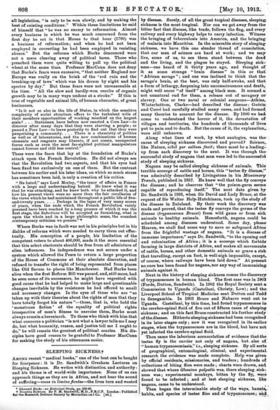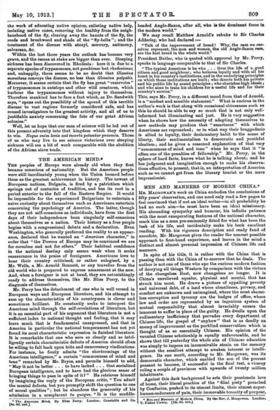SLEEPING SICKNESS.t
AMONG recent " medical books," one of the best can be bought for fourpence : it is Dr. Sandwith's Gresham Lectures on Sleeping Sickness. He writes with distinction and authority : and his theme is of world-wide importance. None of us can approach things as they are in Africa, and not hear the sound of suffering—voces in limine ilentes—the lives torn and wasted • Edmund Burke : an Historical Study, pp. 250-60. Then began the interminable study of the ways, haunts, t Sleeping Sickness. By F. Dd. Sandwith. M.D., P.B.C.P. London : Published fur theMesearch Defence Society by Macmillan and Co. Lid.] habits, and species of tsetse flies and of trypanosomes ; and by disease. Surely, of all the great tropical diseases, sleeping sickness is the most tragical. Nor can we get away from the bitter fact that disease, like trade, follows the flag, and every railway and every highway helps to carry infection. Witness the bringing of tuberculosis into America, and the bringing- of malaria into Mauritius. In the miserable story of sleeping sickness, we have this one slender thread of consolation, that our men of science are hard at work ; and we may live, some of us, to see them stand between the dead and the living, and the plague be stayed. Sleeping sick- ness—one beard of it thirty years ago, and thought of it as some strange "brain disease" in this or that "African savage " ; and one was inclined to think that the savage's brain, at the beat, was only half-awake, and that a form of lethargy, deepening into unconsciousness and death, might well occur "of itself" among black men. It seemed a.: not unnatural end for them, a release out of savagery or slavery. One or two naval or colonial surgeons—Atkins,. Winterbottom, Clarke—had described the disease : Guerin. and Corse had carefully studied many cases, and had formed many theories to account for the disease. By 1900 we had come to understand the horror of it, the devastation of villages and territories, the hundreds of thousands of lives: put to pain and to death. But the cause of it, the explanation,, were still unknown.
Along what lines of work, by what analogies, was the cause of sleeping sickness discovered and proved ? Science,. like Nature, nihit per saltum facit ; there must be a leading- up from each discovery to the next. It was through the- successful study of nagana that men were led to the successful study of sleeping sickness.
Nagana may be called sleeping sickness of animals. this terrible scourge of cattle and horses, this "tsetse fly disease," was admirably described by Livingstone in his Missionary Travels, published in 1857. He knew well that the fly conveys the disease ; and he observes that "the poison-germ seems capable of reproducing itself." The next date given by Dr. Sandwith is 1895, when Sir David and Lady Bruce, at the request of Sir Walter Hely-Hutchinson, took up the study of the disease in Zululand. By their work the discovery was made and proved, that the tsetse fly conveys the germs of the disease (trypanosoma Brucei) from wild game or from sick animals to healthy animals. Henceforth, nagana could be scheduled among diseases understood. Some day, please Heaven, we shall find some way to save or safeguard Africd from the frightful wastage of nagana. "It is a disease of immense importance," says Dr. Sandwith, "to the opening out and colonization of Africa; it is a scourge which forbids farming in large districts of Africa, and makes all movements of cattle, horses, and other domestic animals so grave a risk that travelling, except on foot, is well-nigh impossible, except, of course, where railways have been laid down." At present no cure has been found for nagana, nor any way of immunizing animals against it.
Next in the history of sleeping sickness comes the discovery of trypanosomes in human blood. The first case was in 1901 (Forde, Dutton, Sandwith). In 1902 the Royal Society sent a Commission to Uganda (Castellani, Christy, Low); and the Liverpool School of Tropical Medicine sent Dutton and Todd to Senegambia. In 1903 Bruce and Nabarro went ont tes Uganda. Castellani, by this time, had found trypanosomes in the cerebro-spinal fluid of five out of fifteen cases of sleeping sickness; and on this fact Bruce constructed his further study of the disease. Hitherto sleeping sickness had been recognized in its later stages only ; now it was recognized in its earlies stages, when the trypanosomes are in the blood, but have not yet infected the cerebro-spinal fluid.
Then came the laborious accumulation of evidence that the tsetse fly is the carrier not only of nagana, but. also of " human trypanosomiasis," i.e., sleeping sickness. By all sorts of geographical, entomological, clinical, and experimental research the evidence was made complete. Help was given by official residents, missionaries, and traders ; hundreds of collections of biting flies were made ; charts were drawn, and showed that where Glossina palpalis was, there sleeping, sick- ness was ; experimental monkeys, bitten by the fly, were found to be infected ; and at last sleeping sickness, like nagana, came to be understood. the work of educating native opinion, enlisting native help, isolating native cases, removing the healthy from the neigh- bourhood of the fly, clearing away the haunts of the fly, the reeds and brushwood and shade of the " fly-belts "; and the treatment of the disease with atoxyl, mercury, antimony, salvarsan, &e.
Within the last three years the outlook has become very grave, and the issues at stake are bigger than ever. Sleeping sickness has been discovered in Rhodesia : here it is due to a separate species of trypanosome, not gambiense but rhoclesiense; and, unhappily, there seems to be no doubt that Glossina morsitans conveys the disease, no less than Glossina palpalis. Moreover, it seems certain that the fly has great " reservoirs" of trypanosomes in antelope and other wild creatures, which harbour the trypanosomes without injury to themselves. Therefore mankind has to face a fact which, as Dr. Sandwith says, " opens out the possibility of the spread of this terrible disease to vast regions formerly considered safe, and has roused investigators to the greatest activity, and all of us to justifiable anxiety concerning the fate of our great African colonies."
Well, let us hope that our men of science will be led out of this present adversity into that kingdom which they deserve to win. Neque enins levia aut incerta petuntur praemia. Those of us who may live to see science victorious over sleeping sickness will see a bit of work comparable with the abolition of the African slave trade.











































 Previous page
Previous page